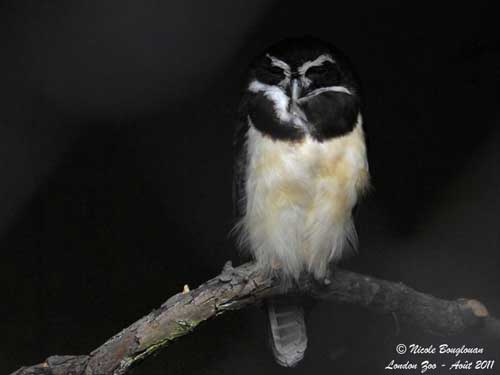
Spectacled Owl
Pulsatrix perspicillata
Strigiforme Order – Strigidae family
BIOMETRICS:
Length: 43-52 cm
Wingspan: 76-91 cm
Weight: 590-980 g
DESCRIPTION:
This large owl is a nocturnal species with conspicuous white spectacles giving the bird its name.
The Spectacled Owl has blackish-brown head and neck. The facial disk is dark brown with white eyebrows and lores.
The upperparts are brown, but slightly paler. The flight feathers and the tail are barred grey-brown.
The underparts are pale buff with white throat and broad dark brown breast band.
The bill is yellowish-white to creamy-white. The eyes are yellow. Legs and feet are feathered.
Both adults are similar.
PROTECTION / THREATS / STATUS:
The Spectacled Owl is very local but fairly common in the habitats where it lives.
This species occurs in numerous protected areas within the wide range. Some populations are much localised due to the deforestation, but the Spectacled Owl seems to be more tolerant of destruction of forest, and may occur in drier woods and cultivated areas.
This species is evaluated as Least Concern by Birdlife International.
Fr: Chouette à lunettes
All : Brillenkauz
Esp : Lechuzón de Anteojos
Ital: Gufo dagli occhiali
Nd: Briluil
Port: Murucututu
Text and pictures by Nicole Bouglouan
Captive birds at London Zoo – UK
Sources :
HANDBOOK OF THE BIRDS OF THE WORLD Vol 5 by Josep del Hoyo-Andrew Elliott-Jordi Sargatal - Lynx Edicions - ISBN: 8487334253
A GUIDE TO THE BIRDS OF COLOMBIA by Steven L. Hilty and William L. Brown - Princeton University Press – ISBN 069108372X
BirdLife International (BirdLife International)
Owling.com – The largest US website totally dedicated to owls
Welcome to WhoZoo (Jill Foley)
XENO-CANTO – Sharing Birds sounds from around the world

The juvenile has white body with barred grey-brown wing-coverts. The facial disk is blackish, forming a dark mask which contrasts strongly against the white plumage.
It needs five years to gain the adult appearance, through several plumage stages to loose the white colour.
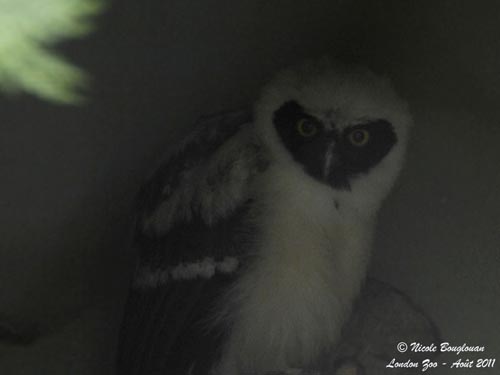
We find six subspecies which slightly differ in plumage tone and eyes colour, from bright yellow or orange to brownish-yellow.
The race P.p. saturata from S Mexico to W Panama is darker and finely barred brown on the pale buff underparts.

VOICE: SOUNDS BY XENO-CANTO
The Spectacled Owl utters rapid descending series of deep, short, rattling hoots “PUP-pup-pup-pup-po” or accelerating “PUM-PUM-pum-pum”. The female gives slightly higher pitched sounds, and duets can be heard.
The alarm call is a series of 3-4 descending low hoots similar to a growl.
The juvenile utters a raspy call “kweew” and a loud whistle “juiiiu”.
This species is often more vocal on moonlit nights.
HABITAT:
The Spectacled Owl frequents the dense tropical humid forest and edges, the savannah woodland and also the dry forest. It mainly occurs in areas with scattered trees, coffee plantations and mangroves. It can be seen up to 1200-1500 metres, but usually at lower elevation.
RANGE:
The Spectacled Owl is resident in its range, from S Mexico and Trinidad, S to S Brazil, Paraguay and NW Argentina.
BEHAVIOUR:
The Spectacled Owl often perches along the streams in gallery forest, and can be seen alone or in pair.
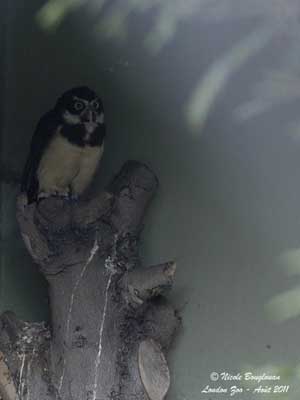
It hunts at night from exposed perch. When the prey is detected, it drops swiftly and catches the prey on the ground or from the vegetation and returns to its perch.
It feeds mainly on small mammals such as opossums, rabbits and several rodents. It takes sometimes bats, amphibians and lizards. Birds such as doves, jays and oropendolas are also caught, as well large insects and caterpillars and small crustaceans. It occasionally may hunt by day. It hunts along forest edges and clearings, or in semi-open savannah with large trees.
During the day, it perches at daytime roost in forest. As other birds’ species, it ejects pellets made with indigestible items, often bones, fur and feathers.
Owl’s displays are poorly known due to their nocturnal habits, but usually, the male becomes fairly vocal some weeks before nesting. Courtship feeding to female accompanied by wing and body movements for the male is common. The mutual preening is used to strengthen the pair-bonds.
The Spectacled Owl is monogamous and cavity-nester.
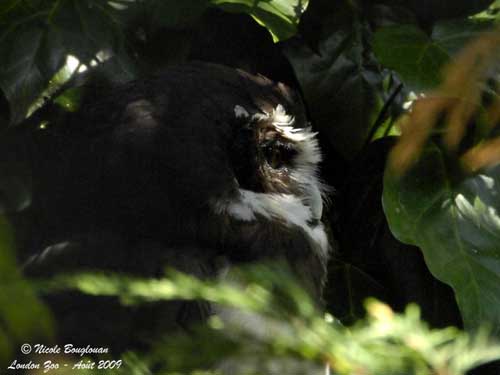
FLIGHT:
As other nocturnal Strigidae species, the Spectacled Owl performs silent flight when hunting at night, thanks to the soft flight feathers.
REPRODUCTION:
The Spectacled Owl breeds in late dry season and early wet season, mostly April/June. But some variations occur according to the range.
This owl nests in tree cavity. The female lays usually two white eggs, rarely three. She incubates during about five weeks.
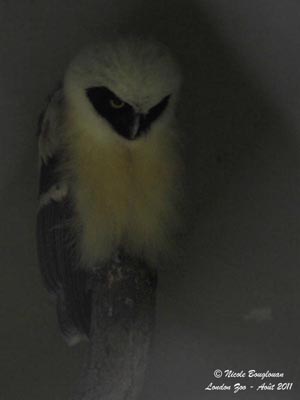
The chicks leave the nest 5-6 weeks after hatching, and perch on the surrounding branches. At this period, they do not fly. They remain with parents during one year after fledging, but often, only one chick survives.
This species may live 25-35 years in wild.
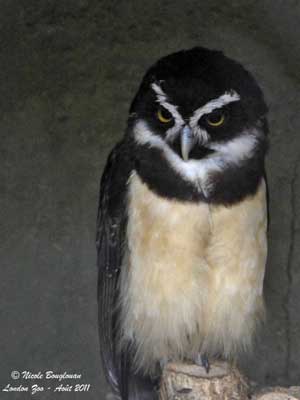
DIET:
The Spectacled Owl feeds primarily on small mammals from rodents to rabbits, birds such as doves, jays and oropendolas, and also takes bats, frogs and lizards, and large insects, caterpillars and small crustaceans.
It hunts from exposed perch and swoops down onto the prey on the ground, or takes it from the vegetation, before to return to its perch.